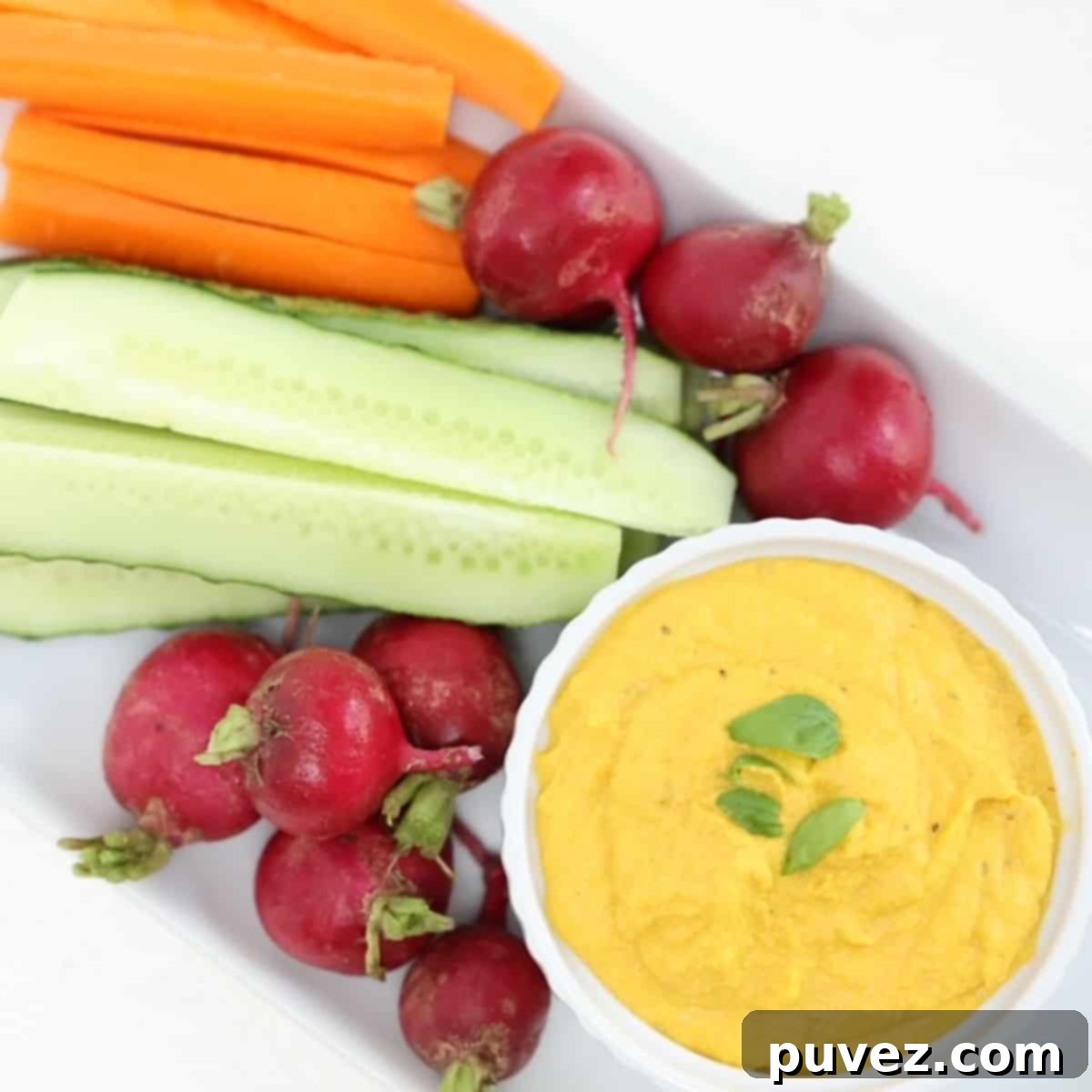5-Minute Raw Carrot Hummus: Your Quick, Healthy, and Flavorful Homemade Dip
Discover how to whip up incredibly delicious homemade Carrot Hummus in just 5 minutes! This dietitian-approved recipe uses simple, wholesome ingredients and skips the roasting, making it faster and easier than traditional methods. Get ready to enjoy a vibrant, creamy, and nutritious dip that’s perfect for any occasion.
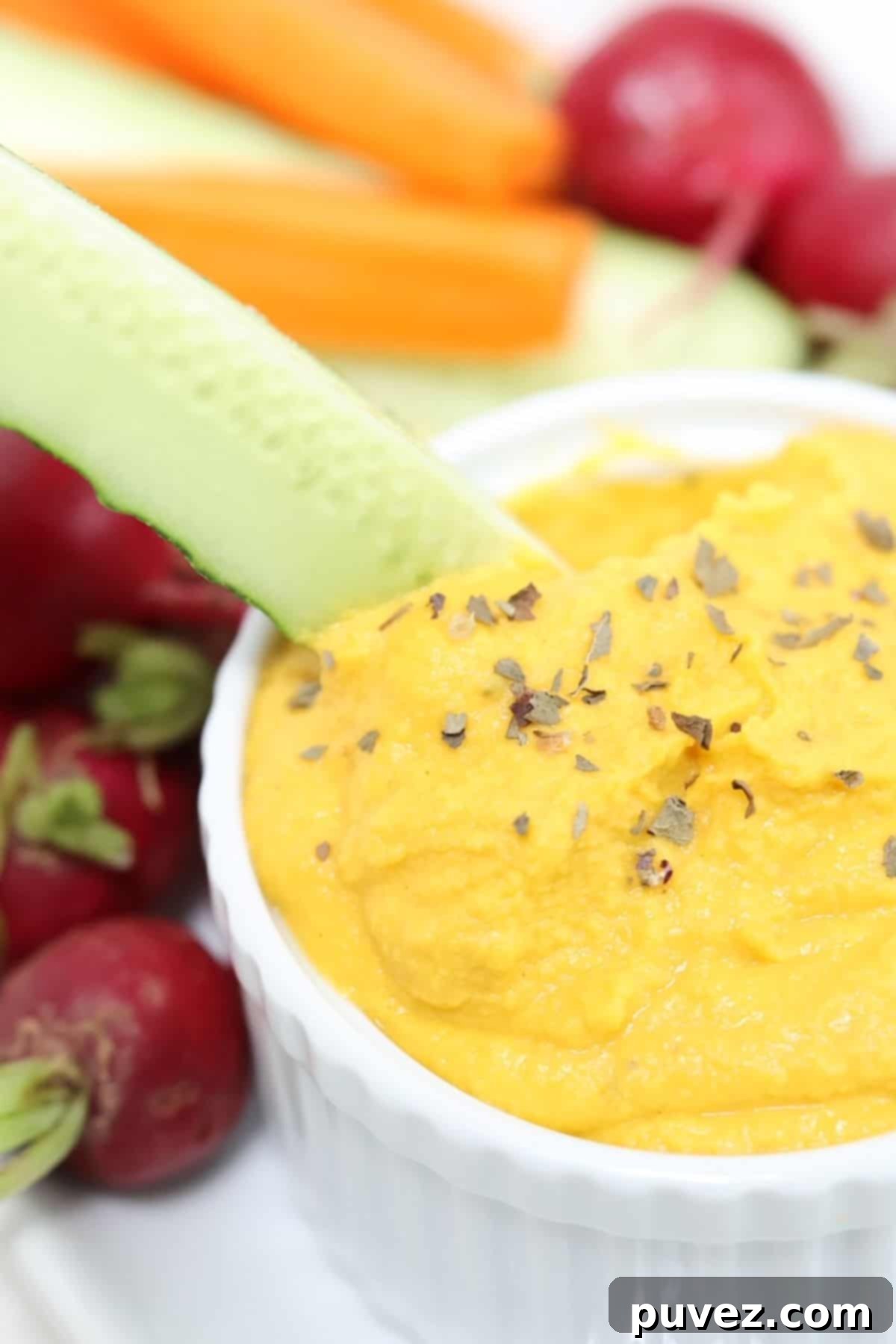
This delightful carrot hummus recipe was originally inspired by the delicious dip served at places like Top Golf, proving that some of the best culinary ideas come from dining out. While traditional hummus often pairs well with carrots, the thought of actually using carrots *to make* hummus was a revelation!
When searching for similar recipes, a common theme emerged: most recipes called for roasted carrots. While roasting can certainly deepen flavors, it adds a significant amount of time to the preparation. For those of us constantly seeking ways to save precious minutes in the kitchen, a faster approach was essential. That’s why extensive experimentation began with using raw carrots, and the results were nothing short of magical – producing a smooth, creamy, and flavorful hummus without the extra steps!
The addition of raw carrots introduces a delightful, subtle sweetness and a beautiful, vibrant color to an otherwise classic hummus. This simple twist not only saves time but also enhances the nutritional profile, making it a win-win for busy individuals and health-conscious families alike. Get ready to transform your snacking and meal prep with this incredibly easy and incredibly tasty raw carrot hummus.
Why You’ll Adore This Easy Carrot Hummus Recipe
- Lightning-Fast & Effortless: Forget the lengthy process of roasting vegetables! This recipe champions raw carrots, slashing your prep time significantly. With just a few simple steps and a good blender, you’ll have a batch of fresh, homemade hummus ready to enjoy in mere minutes. It’s the ultimate solution for busy weeknights or spontaneous snack cravings.
- A Guaranteed Kid-Pleaser: If your children are already fans of classic hummus, they are in for a treat with this carrot-infused version! The natural sweetness from the carrots makes it incredibly appealing to younger palates, often without them even realizing they’re consuming extra vegetables. It’s a clever way to boost their veggie intake in a fun, familiar format.
- Wholesome Plant-Based Power: Crafted entirely from chickpeas and carrots, this hummus is a nutritional powerhouse straight from the garden. It’s naturally vegan, packed with dietary fiber, plant-based protein, and an array of essential vitamins and minerals. Perfect for anyone looking to incorporate more plant-rich foods into their diet for improved health and sustained energy.
- Perfect for Meal Prep: This recipe yields a generous amount, approximately two cups of creamy hummus, making it ideal for meal planning. You can easily divide it into smaller airtight containers for quick snacks throughout the week, or freeze a portion for future use. Having healthy, homemade dips on hand makes healthy eating effortless and ensures you always have a nutritious option available.
Expert Dietitian Insights for Your Health
The American Heart Association consistently champions the importance of increasing your intake of beans and legumes. Incorporating these nutritional powerhouses into your diet is an excellent strategy to boost dietary fiber, which is crucial for digestive health and satiety, while simultaneously helping to reduce the intake of saturated fat and harmful cholesterol. Hummus, being primarily made from chickpeas, serves as a delicious and versatile way to meet these recommendations.
Beyond the commonly recognized fiber and protein, chickpeas and hummus offer a rich profile of essential nutrients that often go unlisted on standard nutrition labels. These include vital components like carotenoids and isoflavones. Carotenoids, abundant in carrots as well, are powerful antioxidants that support eye health and immune function. Isoflavones, found in chickpeas, are plant compounds that have been studied for their potential health benefits, including heart health and bone density. This makes your carrot hummus not just tasty, but a truly nourishing choice.
Making hummus a staple in your kitchen is an effortless way to integrate more legumes into your daily meals. Whether you’re enjoying it as a vibrant dip with crunchy vegetables and pita bread, spreading it generously on whole-grain wraps and sandwiches for a hearty lunch, or even experimenting with it as a base for unique pasta sauces or salad dressings, hummus provides a versatile and nutrient-dense foundation for healthier eating habits. It’s a simple switch that brings significant health benefits.
Key Ingredients for Perfect Carrot Hummus
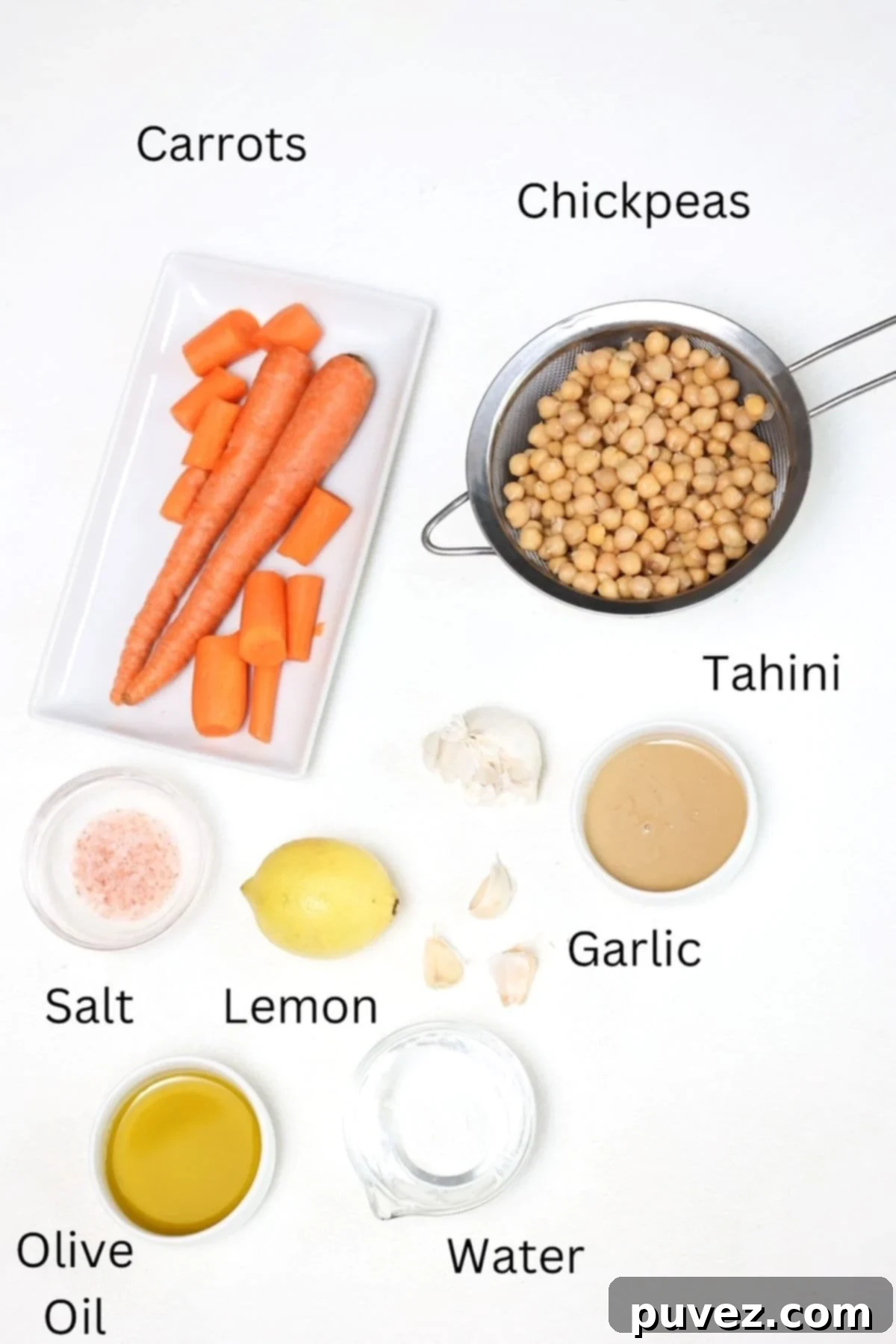
- Chickpeas (Garbanzo Beans): The foundation of any great hummus! Use one standard 15½ ounce can of chickpeas. Be sure to rinse and drain them thoroughly before use to wash away excess sodium and any canning liquid that might affect the flavor. Chickpeas are incredible legumes, offering a host of health benefits, including high levels of plant-based protein, dietary fiber, and various minerals like iron and folate, which contribute to satiety and digestive health.
- Carrots: The star of this unique hummus! You’ll need about two medium-sized carrots, which equates to roughly one cup of sliced raw carrots. Carrots are famously rich in fiber and beta-carotene, a powerful antioxidant that the body converts into Vitamin A, essential for vision, immune function, and skin health. Their natural sweetness adds a wonderful depth of flavor to the hummus, balancing the tangy lemon and earthy tahini.
- Tahini: This paste made from ground sesame seeds is non-negotiable for achieving that authentic “classic hummus” taste and creamy texture. Tahini provides a distinctive nutty, slightly bitter flavor that is crucial for balancing the sweetness of the carrots and the acidity of the lemon. You can typically find tahini in the international, ‘natural,’ or ‘organic’ sections of most grocery stores. Its consistency is similar to natural peanut butter, but its flavor profile is distinctly different and integral to hummus.
- Fresh Lemon Juice: Always opt for fresh lemon juice over bottled for the best flavor! The bright, zesty notes of freshly squeezed lemon are vital for cutting through the richness of the tahini and adding a refreshing tang that elevates the entire hummus. It truly brings out the best in the other ingredients, contributing significantly to the traditional hummus flavor profile.
- Extra Virgin Olive Oil: I highly recommend using a good quality extra virgin olive oil. While it is possible to make hummus without oil, the texture can become quite gritty and less enjoyable. Olive oil plays a crucial role in achieving that coveted smooth, velvety, and creamy consistency that makes hummus so irresistible. It also adds a subtle fruitiness and healthy monounsaturated fats.
- Optional Seasoning (Basil & Thyme): For this recipe, dried basil and thyme were chosen for their subtle yet complementary flavor and because they are pantry staples for many home cooks, unlike fresh herbs which can spoil quickly. Moreover, some individuals are not fond of cumin, a spice often found in traditional hummus, so this recipe offers a delicious alternative. However, remember that cooking is an art of personal preference! Feel free to customize your hummus by adding a pinch of cumin, a dash of smoked paprika, or a handful of fresh parsley or cilantro if those are flavors you enjoy and have on hand.
Effortless Raw Carrot Hummus: A 5-Minute Guide
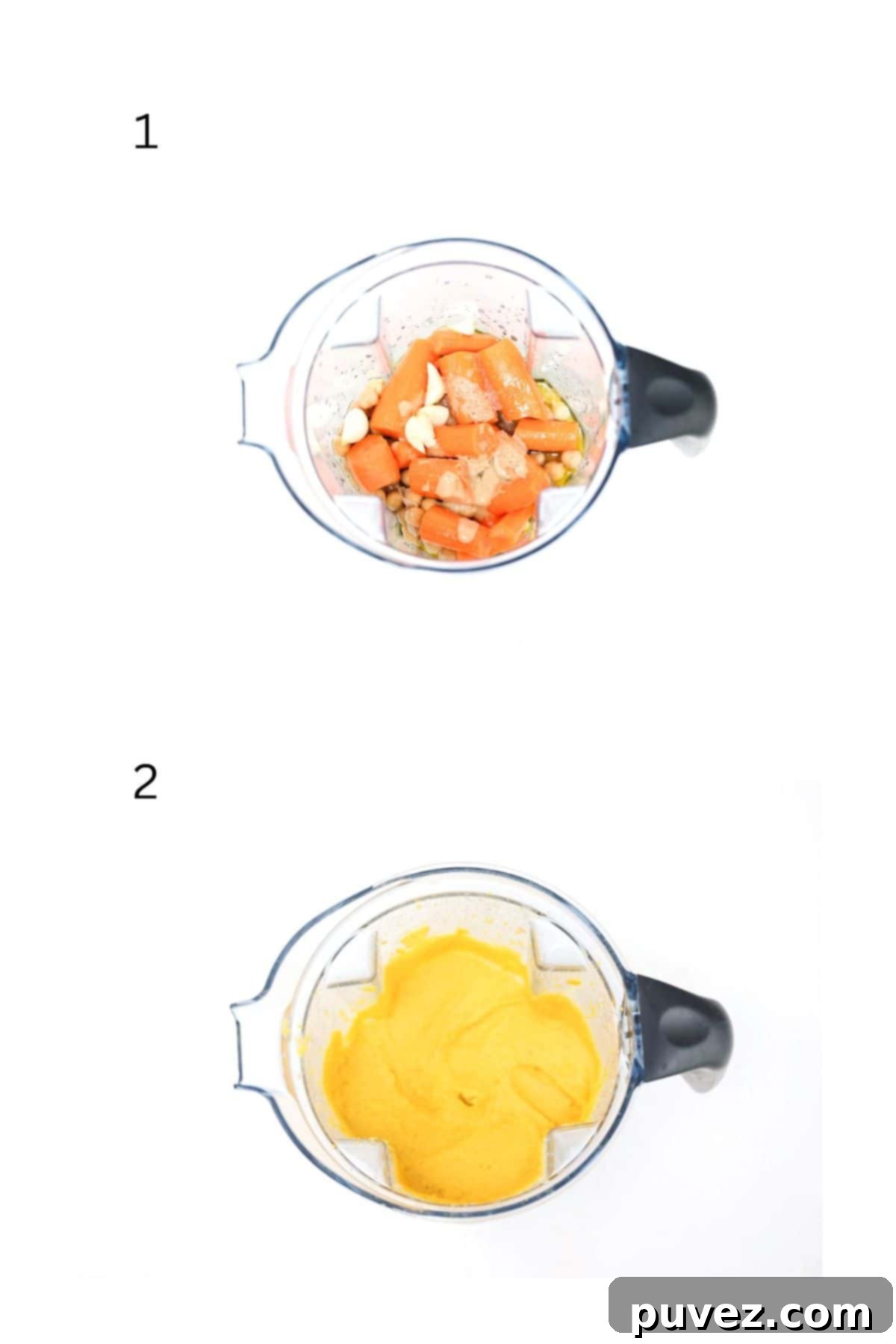
Preparing this vibrant carrot hummus is incredibly straightforward, perfect for those moments when you need a quick yet healthy dip. Below is a concise overview of the steps. For a comprehensive list of all ingredients and detailed instructions, please refer to the full recipe card located further down the page.
- Begin by adding your rinsed and thoroughly drained chickpeas to a high-powered blender. Next, incorporate all the remaining ingredients into the blender, making sure to add the sliced raw carrots last. This layering can sometimes help with initial blending.
- Start blending on a low speed to help break down the ingredients. Gradually increase the blender speed to high, continuing to blend until the mixture transforms into a wonderfully smooth, uniform, and creamy consistency. Use a tamper if your blender has one to push ingredients towards the blades for optimal blending.
Creative Ways to Enjoy Your Carrot Hummus
- Versatile Dip: The most classic way to enjoy hummus! Serve it as is for a simple snack, or elevate it with a generous drizzle of high-quality olive oil and a sprinkle of toasted pumpkin seeds, sesame seeds, or a pinch of paprika for an extra pop of flavor and visual appeal. It pairs beautifully with a wide array of dippers, including crunchy pita chips, warm and fluffy pita bread, savory pretzel thins, or an assortment of fresh raw vegetables like cucumber spears, bell pepper strips, celery sticks, and cherry tomatoes. Blanched green beans or broccoli florets also make excellent, nutritious dippers.
- Flavorful Spread: Transform your everyday meals by using carrot hummus as a vibrant and nutritious spread. It’s an excellent alternative to mayonnaise or other creamy spreads for wraps, sandwiches, and even toast. Spread a thick layer on whole-grain bread with your favorite veggies and protein for a quick, wholesome lunch. It adds moisture, flavor, and a creamy texture that’s incredibly satisfying.
- Unique Pasta Sauce: Unleash your culinary creativity by thinning out your carrot hummus to create an unexpectedly delicious and healthy pasta sauce. Simply whisk in some vegetable broth or water until it reaches your desired consistency. Toss it with your favorite pasta, a handful of fresh spinach, and perhaps some cherry tomatoes for a light yet flavorful Mediterranean-inspired meal. It’s a fantastic way to introduce more plant-based goodness to your pasta dishes.
- Creamy Salad Dressing: Lighten up your salad routine by thinning a portion of the hummus with a little water, lemon juice, or apple cider vinegar to achieve a pourable consistency. This homemade dressing is perfect for drizzling over a fresh Mediterranean-style salad, adding a rich, creamy texture and a burst of savory flavor. It’s a wonderful way to add healthy fats and fiber to your greens without relying on store-bought dressings.
Helpful Tips for Hummus Perfection
- Rinse Chickpeas Thoroughly: Always make sure to rinse and drain your canned chickpeas very well under cold water before adding them to the blender. This step removes excess sodium and any starchy liquid that can affect the flavor and texture of your hummus, ensuring a cleaner taste.
- Opt for Fresh Garlic: For the most potent and authentic flavor, use fresh whole garlic cloves instead of pre-minced, jarred garlic. Fresh garlic offers a brighter, more aromatic punch that truly elevates the taste of your homemade hummus.
- Utilize Your Blender’s Tamper: If you’re using a high-powered blender, a tamper is your best friend. It helps push the ingredients down towards the blades, ensuring everything gets thoroughly blended and prevents the mixture from getting stuck, resulting in a much smoother and creamier consistency.
- Customize Your Seasoning: While basil and thyme are recommended for their subtle, complementary flavor, feel free to experiment. If you enjoy the warm, earthy notes of cumin, add a pinch or two to taste. Fresh herbs like parsley or cilantro can also add a delightful freshness.
- Achieving Extra Creaminess: For an exceptionally creamy hummus, you have a couple of options:
- Roast the Carrots: If time allows and you prefer a deeper, sweeter flavor, roasting the carrots first can lead to an even smoother texture and richer taste.
- Add More Olive Oil: Incorporating an additional tablespoon of high-quality extra virgin olive oil during blending can significantly enhance the silkiness of your hummus.
- Oil-Free Hummus Considerations: While you technically *can* make this hummus without oil, be prepared for a noticeable difference in texture. It will likely be much grittier and less creamy, lacking the luxurious mouthfeel that olive oil provides.
- Salt is Essential for Flavor Balance: Salt is a crucial ingredient in this recipe, bringing out and balancing all the other flavors. It can be tricky to recommend an exact amount as individual palates vary. If you typically prefer less salty food, start with just one teaspoon of salt.
- Taste and Adjust Salt: For those accustomed to saltier foods, or if you’re unsure, taste the hummus after it’s finished blending. You can always add more salt a quarter teaspoon at a time until it meets your preference. It’s easier to add more than to correct an overly salty batch.
- Blender vs. Food Processor: A high-speed blender is highly recommended for the smoothest possible texture, especially with raw carrots. When made in a standard food processor, you might find small, unblended pieces of carrot, resulting in a slightly coarser texture. The image in the original post illustrates this difference.
- If You Don’t Have a High-Speed Blender: If your blender isn’t powerful enough to achieve a silky smooth consistency with raw carrots, I strongly suggest converting this into a roasted carrot hummus recipe. Simply roast the carrots until tender before blending. It adds a bit more time but guarantees a superior texture if you lack a high-speed appliance.
Frequently Asked Questions About Carrot Hummus
Yes, absolutely! You can freeze carrot hummus in an airtight, freezer-safe container. However, it’s important to manage expectations regarding texture. Once defrosted, the hummus may be slightly less smooth or a bit grainier than freshly made. For the best results, allow frozen hummus to defrost slowly in the refrigerator overnight before serving. A quick stir can help restore some of its original creaminess.
Technically, yes, you can prepare hummus without oil, but I generally advise against it for this particular recipe. The smooth, luxurious texture that is characteristic and highly appreciated in hummus largely comes from the emulsifying properties of the olive oil. My own experiments in creating an oil-free version resulted in a much grittier, less appealing consistency. If you’re aiming for that classic creamy hummus, oil is a key ingredient.
Storing leftover carrot hummus is simple. Transfer it to an airtight container and keep it in the refrigerator for up to 5-7 days. For longer storage, you can also freeze it, as mentioned above. Just be sure to press a piece of plastic wrap directly onto the surface of the hummus before sealing the container to prevent a skin from forming and keep it as fresh as possible.
You can certainly use purple carrots in this recipe if you wish to experiment with different varieties. They offer similar nutritional benefits to orange carrots. However, be aware that purple carrots will significantly alter the color of your hummus, giving it a unique, darker, and potentially less vibrant hue than the bright orange you’d expect from traditional carrots. While the flavor will be similar, the visual appeal might be quite different!
Explore More Delicious Dips
- Easy Edamame Hummus
- Simple 4-Ingredient Guacamole
- Sweet Strawberry Cream Cheese Dip
Discover More Quick & Simple Recipes
- Easy Roasted Peaches
- Butternut Squash Pasta Sauce
- Simple Lemon Garlic Salad Dressing
- Why is Fiber Important?
Did you try this incredibly easy 5-Minute Carrot Hummus recipe and fall in love with it? Please share your experience by leaving a comment below and a ⭐⭐⭐⭐⭐ star review! Your 5-star rating is truly the highest compliment and helps others discover this amazing recipe!
Don’t miss out on more effortless recipes, valuable nutrition tips, and daily inspiration! Be sure to follow me on Pinterest and Instagram!
📖 Recipe
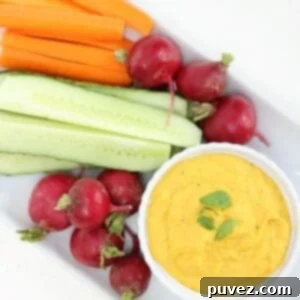
5-Minute Carrot Hummus
Kristi
Pin Recipe
Equipment
-
1 Blender use a high-speed blender for a creamy hummus
-
1 tamper Use a tamper made to be used with your blender to ensure smooth blending.
-
measuring cups and spoons
Ingredients
- 15½ ounces canned chickpeas One 15½ ounce can, rinsed and drained thoroughly.
- 2 carrots Medium sized, peeled and sliced (approximately 1 cup raw).
- 3 tablespoons tahini
- ¼ cup lemon juice freshly squeezed for best flavor.
- 3 cloves garlic peeled.
- 3 tablespoons olive oil extra virgin, for creaminess.
- 1¼ teaspoon salt
Instructions
-
Add all the ingredients to a high-speed blender. Start with the rinsed and drained chickpeas, then add tahini, lemon juice, garlic, olive oil, and salt. Finally, add the sliced carrots on top.15½ ounces canned chickpeas, 3 tablespoons tahini, ¼ cup lemon juice, 3 cloves garlic, 3 tablespoons olive oil, 1¼ teaspoon salt, 2 carrots
-
Begin blending on low speed, gradually increasing to high. Continue to blend, using a tamper if necessary, until you achieve a perfectly smooth and creamy consistency. This usually takes about 2 minutes.
-
Taste and adjust salt or lemon juice as needed. Serve your fresh carrot hummus immediately, or transfer it to an airtight container and refrigerate for later enjoyment.
Notes
- For the creamiest texture, especially with raw carrots, use a high-speed blender and a tamper to keep the ingredients moving towards the blades.
- If using a food processor, you might notice small pieces of carrot remaining, leading to a slightly less smooth hummus. For a smoother result with a food processor, consider roasting the carrots first.
- Optional additions like dried basil and thyme introduce a subtle, aromatic flavor. For a more traditional hint, add a pinch of ground cumin before blending.
- To achieve an even creamier hummus, you can either roast the carrots until very tender before blending, or simply add an extra tablespoon of olive oil to the mix.
- Making this hummus without any added oil will result in a much grittier texture, as the oil contributes significantly to its smooth consistency.
- Salt is essential for balancing and enhancing the flavors. Start with one teaspoon if you prefer less salty foods, and adjust to taste after blending.
- Always taste your hummus after blending. If you find it needs more zest or depth, add a little extra lemon juice or salt, blend again briefly, and re-taste.
Nutrition
